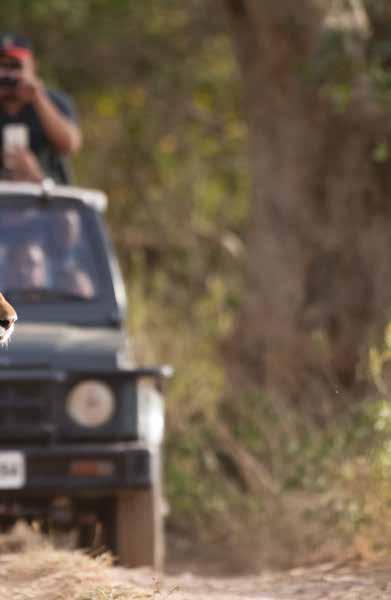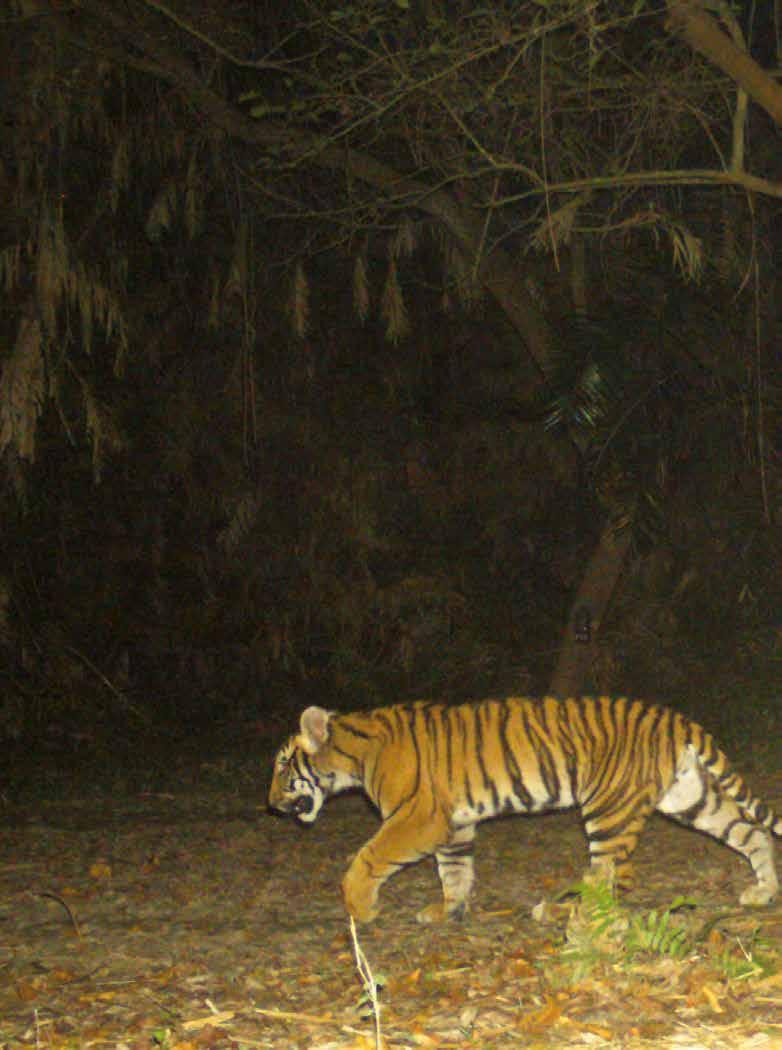
4 minute read
Feature story: How Pilibhit Tiger Reserve more than doubled its tiger population
©Worrapan Phumanee / WWF-Thailand Visitors at the Tiger Education Centre, Thailand
Tourists on a wildlife tour at Ranthambore Tiger Reserve, India WWF applied the SAFE tool to support Huangnihe National Nature Reserve in Jilin Province and Dajiahe Provincial Nature Reserve in Heilongjiang Province to conduct an assessment to better understand the challenges of human wildlife conflict. From 2019 to 2020, WWF and Jilin University conducted a survey on environmental conservation awareness of communities in Huangnihe National Nature Reserve. Pilot sites were selected and a human wildlife conflict rapid response team was formed.
Advertisement

COMMUNITY RESPONSE GROUPS IN INDIA
A team referred to as Bagh Mitras, which translates to Friends of Tigers, has been trained in an area with high human tiger conflict in Pilibhit Tiger Reserve and South Kheri Forest Division in Uttar Pradesh. The team is formed by volunteers from the local community and their main role is to provide support to the Uttar Pradesh forest department during instances of human tiger conflict. The team is the first line of support to manage a conflict situation until the forest department is available. To date 75 Bagh Mitras in Pilibhit Tiger Reserve and 50 Bagh Mitras in South Kheri Forest Division have been trained by WWF-India. Pilibhit Tiger Reserve was awarded the inaugural TX2 Award for doubling their wild tiger population, in the following feature we find out how it was achieved.
THE COST OF CONFLICT
The report ‘Economic Impact Assessment of Human Wildlife Conflict in India and Nepal’ in selected sites in India and Nepal was completed in 2020. The report, supported by WWF, is the first globally to test and apply a method for assessing economic costs of human wildlife conflict, and highlights that the relative cost of tiger conflict is highest where human tiger contact is highest. In the Sundarbans, human mortality due to tigers represents 100% of the annual cost to society, while in the Terai Arc Landscape in India it represents 96% of the total cost of human wildlife conflict. In contrast, the cost of tiger conflict in the Terai Arc Landscape in Nepal is only 28% of the total conflict cost, due to crop and property losses by elephants and herbivores being the dominant conflict at 72%. The findings are critical for us to be able to tailor human wildlife conflict management responses to the specifics of the conflict profile locally.
TIGER EDUCATION IN THAILAND
In 2020 WWF along with multiple agencies collaborated with a key school near Khlong Lan National Park, a WWF Heartland site, to build a “Tiger Learning Center”. This Center will provide local students with the opportunity to experience and learn about tigers and other wildlife found in Thailand. It will help the younger generation to understand the importance of tigers and wildlife in maintaining healthy ecosystems that humans also depend on. Increased awareness and appreciation by local people will contribute to saving this keystone species.
©NTCA / UPFD / WWF-India

Tigers caught on camera trap in Pilibhit Tiger Reserve, India
FEATURE STORY
HOW PILIBHIT TIGER RESERVE IN INDIA MORE THAN DOUBLED ITS TIGER POPULATION
Located in northern India, Pilibhit Tiger Reserve is one of the narrowest tiger reserves in India. The surrounding areas support among the highest human population densities of all tiger conservation landscapes globally. Yet the tiger population of Pilibhit Tiger Reserve doubled over the last decade and stands at 65 as of 2018. In recognition of this success Pilibhit Tiger Reserve was presented with the inaugural TX2 Award, for its remarkable contribution to tiger conservation.
©Rebecca May / WWF-UK Pilibhit Tiger Reserve, India

The forest lies in a heavily populated landscape where grasslands and agricultural land blend with the edge of the forest. Pilibhit’s forests are frequented by people all year round, so it can be difficult to find a balance between wildlife and people. But with every challenge lies an opportunity.
There have been a number of key successes to Pilibhit doubling it’s tiger population. Like every animal, tigers need to eat. To increase the number of prey in the reserve for tigers, habitats such as forests and grasslands have been greatly improved. Another key success is the investment of technology to improve patrolling and monitoring. Better equipping them reduces the threat of poaching and ensures the habitat is a safe haven for tigers and other wildlife moving through it.
Even with these solutions there remains challenges. Because of its location the agricultural areas that surround Pilibhit act as an extension of natural habitats. This means tigers and other species often move beyond forest boundaries. It is an immense challenge, there is a real risk of close encounters between people and tigers which tragically results in both human fatalities and retaliatory killing of tigers. WWF-India is working closely with the government, other agencies and communities to better manage the impacts of conflict, making the landscape safer for both people and tigers.
The increase of tiger populations in Pilibhit demonstrates that committed efforts and investment in conservation can quickly yield results in areas where tigers thrive.










